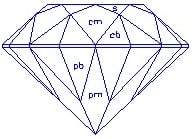- 14 Posts
- 34 Comments
You also have a decreased risk of ovarian cancer if you completely remove your fallopian tubes, and it doesn’t require an 18.75 year financial, emotional, medical, and time investment to gain.
The faceting community would welcome anyone who wants to create a wine pairing guide for our lickable rocks.
I’m not actually sure. Typically faceting uses water to keep the stone cool while grinding. The water would dissolve the sugar and the friction heat would melt and move the candy ever so slightly so I’d never get a perfect polish or accurate meetpoints. If an oil coolant was used, I’m not sure the stone would be edible after… And that doesn’t even touch on what a nightmare it would be to clean sugar out of my equipment.
Conceptually, with a lot of foresight, you might be able to do a really crappy faceting of a piece of candy. Realistically it’s a nightmare idea and an expensive mess.
I can confirm it it does NOT taste like one!! 😭
It’s not a silly question at all 😄 faceting is one of those rare hobbies to stumble across in the real world.
For perspective, this stone took me about 8 hours to cut, so this little comment probably makes the execution sound simpler than it is. Most faceters use a diagram to cut which tells them the precise angle as well as location on the the stone to cut that angle.
We glue our uncut stone to a stick, called a “dop”, to attach it to our angle machine.
We have spinning discs, called “laps” that are basically like sandpaper but made with diamonds instead of sand. When we cut the stone we start at very low grit laps which will cut fast but leave behind deep, rough scratches, then we progress to finer and finer grit laps until the diamond scratches are so microscopic that to a 10x magnification the stone still looks flawlessly polished.
We do this grinding technique to one half of the stone at a time, typically the pavilion (the backside of the gem) first and then the crown (top half) second.
Crylos has actually posted a much more in depth how-to earlier in this community if you want to drive deeper into the rabbit hole of faceting.
In this stone, the frosted facets are actually un-polished areas of the stone, so the snowflake you see is actually very fine scratches that aren’t bouncing light correctly, creating the “line” appearance. There’s multiple facets on the crown, so it is bouncing the “line” appearance through different angles, making it look way more complex than it actually is.
Here’s a photo of the frosting lines on the pavilion. Deceptively simple compared to what you see on the final product, isn’t it? 🤭


 5·9 个月前
5·9 个月前For a beginner I always recommend you start with something square/rectangle, as the roundabout with socks is an intermediate difficulty. Scarves or baby blankets make lovely gifts, and are very beginner friendly.
Once you are confident in the basics of how to knit, you can kick it up a notch by trying socks.
Honestly most every beginner knitting guide on the internet is great. There’s YouTube guides for whose who want videos and written guides for those who prefer standstill photos and text. And if you really need a physical teacher, try to find a local MakerSpace in your city - yarn wizards are plentiful in those spaces and we get EXCITED at bringing a newbie into our world!

 4·9 个月前
4·9 个月前You are a genius, I never thought of doing this before!

 3·9 个月前
3·9 个月前I too love knitting socks!! I only wear my own socks these days, they’re just so comfy and they always have fun colors.
But the real question is: are you team Toe Up or team Top Down?

 19·9 个月前
19·9 个月前I’ve been knitting for a decade but only made my first pair of socks during the pandemic. I bought some wool from a reputable seller in fun colors. It was so fun and they were so comfy, I made several more.
I almost never wear anything other than my knitted socks these days. They’re just so daggone comfy and they keep my feet warm yet they never feel sweaty, except on extremely hot days when I’m outdoors.
Wool socks are absolutely luxurious to me now. 10/10 recommend knitting socks if you haven’t already!

 1·10 个月前
1·10 个月前Audiobooks. I’ve “read” over a hundred books by now, all while knitting.
There are free ones on librivox.org if you want to try it without spending money to see if it’s something you can do.

 2·10 个月前
2·10 个月前3.6 minutes in the context of a 40 hour work week is a 0.15% increase in work. No sane person would consider that clinically significant. If they’re claiming there’s a significant difference of 0.15% between the groups, they’re making shit up.

 15·10 个月前
15·10 个月前Some dishes freeze well, so those leftovers can be turned into future meal prep. I liked freezing my chili in silicone muffin tins, then one or two thawed chili pucks was a perfect last-minute meal when I didn’t feel like cooking.

 11·11 个月前
11·11 个月前Maybe it was… copious amounts… and gravity utilized the pant leg openings…
Brb gonna puke from my own mental image

 9·11 个月前
9·11 个月前Based on the article, the device will host actual kidney cells - I’m sure it won’t be as effective as having your own original kidney, especially in it’s early prototypes, but hopefully it’ll be better than mere dialysis.
Even if the device was just a glorified portable dialysis machine though, that would still be a significant quality of life improvement for those on dialysis. With dialysis you’re locally tethered to the dialysis clinic because you need weekly treatments, until you eventually die or win the kidney lottery. With a portable machine you could hopefully travel, see the world and visit family more.
Be kind to your kidneys everyone, drink enough water! You don’t want a life without efficient kidneys.

 27·11 个月前
27·11 个月前I don’t know which episode, but the signs originally said “we don’t take itchy & scratchy money”. Hope that helps!

 6·11 个月前
6·11 个月前It’s not actually blue. If there are two full moons in the same calendar month, the second full moon is referred to as “blue”. It will be the same color it always is.
It would be a helluva lot cooler if it actually was blue, but alas…

 34·11 个月前
34·11 个月前Holy hell, that’s straight up evil if true. I hope the bad PR ran them out of business.

 18·11 个月前
18·11 个月前So when he offered to send someone a duck pic, it wasn’t an autocorrect?




OMG that fire is insane!! Your son is really doing an amazing job, you must be so proud! I guess you could even say he’s… brilliant 🤣